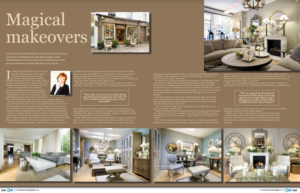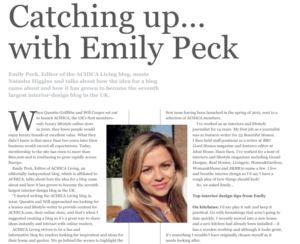Once hit by Cholera and home to displaced pigs and their keepers but now home to properties worth millions, Natasha Higgins tells us what Notting Hill has to offer.
When cholera hit London in the mid 1800s, Notting Hill and its surrounding areas were worst affected. This was due to the large number of pig keepers that moved over in the 1820s, after being forced out of areas such as Edgware Road and Marble Arch as London expanded westwards.
The bottom part of Notting Hill, North Kensington, became known as the Piggeries and Potteries. In a magazine called Household Words, Charles Dickens famously wrote about the level of sanitation during that time:
“In a neighbourhood studded thickly with elegant villas and mansions: Bayswater and Notting Hill, in the parish of Kensington, is a plague-spot scarcely equalled for its insalubrity by any other in London; it is called the Potteries”.
Despite the lethal effects of contaminated water, it wasn’t until the late 1870s that the pigs were finally removed.
CS_area_1206_CWhen taking a casual stroll down fashionable streets such as Pottery Lane in and around Notting Hill today, there is little evidence of the former slums where people lived amongst pigs, sludge and filth.
From Piggeries and Potteries to chic west London hub, Notting Hill has grown to become one of the most sought-after residential spots in the capital. With properties in the millions, and everyone desperate to buy, what are the key facts?
Director of Winkworth, Notting Hill, Alex Thomson, tells us which roads in the area, in his opinion, are most desirable: “A number of streets might be classed as Notting Hill’s most desirable for their own individual attractions but the top four would be: Dawson Place, Pembridge Place, Clarendon Road and Lansdowne Road. Prices on these roads can vary from £5,000,000 to £40,000,000.”
“In terms of architecture, the most familiar style of properties are terraces of white stucco fronted houses backing onto private communal gardens.”
Thomson further explains that although Notting Hill has become defined by its international cross section of residents, not all are international investors. Many are international by domicile but have been London residents for a good number of years.
Has Notting Hill always been this trendy? “No,” says Thompson. “Notting Hill’s appeal was originally quite the opposite, being definitively bohemian. As bohemia itself became fashionable however, Notting Hill’s popularity increased and up went property prices which were the catalyst for its transformation into the chichi, fashionable village it has become”.
The area also appeals to young families. Director of Bective Leslie Marsh, Keith Rigby, says Notting Hill has fantastic nurseries, prep schools and outstanding public schools.
In Rigby’s opinion, the most desirable roads in Notting Hill are any property around communal gardens such as Dorset Place and Kensington Park Gardens. “Average properties on these roads are priced at over £5,000,000”.
Which areas nearby are still good value? “W2 Bayswater or Queensway still offer good value but all is relative as they are still expensive,” says Rigby.
So what exactly makes Notting Hill so popular? Its stunning architecture, central location, sophisticated bars and restaurants, Portobello Road’s legendary market and its overall charm all contribute. Here’s a flavour for what’s around:
Restaurants and cafes
On a sunny day, there is often no better place than the Electric Brasserie on Portobello Road to sit and soak up Notting Hill’s cool vibe. It’s a popular choice, especially at weekends, but the good food and atmosphere make it a worthwhile choice.
Alternatively, at the top of Portobello Road is Pizza East, a stylish pizzeria with an outdoor terrace serving delicious ten inch pizzas made from a house recipe and baked in a stone oven. The salted caramel tart will make you pretty happy too.
For an exquisite Italian meal, in relaxed surroundings, look no further than Assaggi on Chepstow Place. The starter of Pecorino cheese with Parma ham on pancakes is enough to go back time and time again. This local’s favourite is about as authentic as it gets.
For a light bite, 202, on Westbourne Grove, is full-on chic. In spring, when the cherry blossom is out and sunglasses start making their first appearances, there is a real buzz to Westbourne Grove. Spend a relaxing afternoon at this eatery and shamelessly indulge in people watching. .
Bars
Tucked away between Ledbury Road and Colville Road is Notting Hill’s famous Lonsdale bar. It’s popular with the trendy west London crowd and with a menu comprising over 80 cocktails and 200 spirits there’s something for everyone!
For a bit of wow-factor, the stunning interior of Beach Blanket Babylon, a former Georgian mansion, is a must see. This Notting Hill hotspot combines the ornate, the decadent, the bohemian and the elegant. It’s full of glamorous people and has an air of sophistication – a good night is guaranteed.
Trailer Happiness has it all. A great name, great cocktails and a top atmosphere. Head to Portobello Road where it’s all happening and enjoy some kitsch glamour.
Delis and fresh produce
Daylesford Organic Farmshop & Cafe sells organic meat, fresh bread, fruit and vegetables, cheese, wine and more. Located in the heart of Notting Hill, seasonal produce is delivered daily. One couldn’t wish for a better local grocer; the quality of the produce is instantly noticeable as is the taste.
You can’t beat a good deli. Toms Deli has become something of an institution, having opened in 1990. Famed for its ‘Full English’ breakfast served at its upstairs cafe, it’s exactly the place you’d want to have on your doorstep!
Hair salon
With Summer arrived, it’s time to get glamorous. Kell Skott Haircare, Notting Hill’s legendary hair salon is our first point of call. New on their list of treatments is one that removes frizz from your hair leaving it looking ultra glossy. The properties of argan oil are combined with steam from the high tech ‘MicroMist’ machine allowing conditioners to permeate deeper into damaged hair. “The result is repaired, rejuvenated and frizz-free hair,” explains Jacqueline Skott, Salon & Marketing Director. The salon itself is an oasis of calm – everything has been thought of including the chocolate brownies and a fresh mint tea mid-way through the session – ah, paradise! The treatment is priced at £80 and includes a full blow dry.


